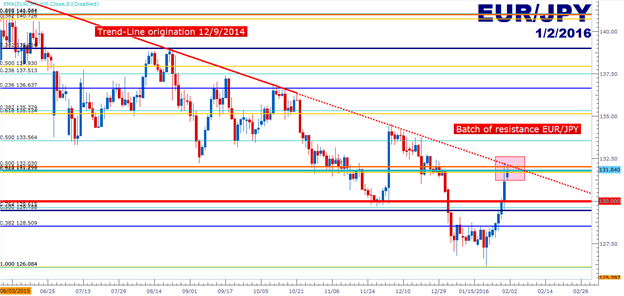To receive James Stanley’s Analysis directly via email, please sign up here.
Talking Points:
- EUR/JPY Technical Strategy: Short reversal setup identified (aggressive)
- EUR/JPY got much needed relief after the pummeling down-trend caught support to end the month of January.
- Both Euro and Yen are in the spotlight as both economies are utilizing negative rates. To get our big picture analysis, check out our Trading guides with forecasts for each currency.
The Bank of Japan shocked the world by moving interest rates into negative territory at their most recent policy meeting. Before that, only Europe had dabbled with sub-zero deposit rates and that’s only been for the past year-and-a-half, so to say that the prospect of a major economy using negative rates is still ‘new’ would be quite the understatement. The move was largely tokenary in form as the cut was a simple 20 basis points to move the BoJ rate from .1 to -.1; so we’re not talking about a huge move here. But it is emblematic, and Mr. Kuroda said at the accompanying press conference that he’d go more negative if need-be.
This makes the prospect of staying long the Yen rather daunting, at least if you’re marrying the Yen up with anything that doesn’t have more dire prospects than the Japanese economy. And as unfortunate as it may be, there is an economy with just that scenario in Europe. In Europe, rates are already negative and they could go even further below zero. The optimistic silver lining here is the idea that European Central Bank may be able to go for more QE at their March meeting, and the ECB looks far more equipped to embark on an increase to QE than Japan does.
But that, for all intents and purposes, presents a neutral tone in EUR/JPY. What makes this compelling is the technical setup. The rip on Friday after the BoJ’s announcement sent price right into a relevant zone of resistance that we’ve been discussing over the past few months. This is the zone from 131.67-132.03, where no fewer than three relevant Fibonacci levels fall. There’s also a 13-month trend-line projection in this vicinity as well. This confluent zone contains the 61.8% retracement of the most recent major move at 131.80 (in aqua), the 50% retracement of the secondary move at 132.03 (in orange, can be found by taking the 2008 high to the 2012 low) and the 76.4% retracement of the tertiary move at 131.675 (in yellow, taking the 2014 high to the 2015 low).
After Friday’s massive counter-trend rip, traders are faced with a decision: Do they want to hit the setup aggressively or more conservatively? The aggressive setup could be taken now with a stop above the next level of potential resistance at 132.50. The high on Friday came in at 131.27, and with a major psychological level so closely nearby, traders can look to wedge stops for short positions above that 132.50 level to take on ~70 pips of risk. This could open the door for a 1-to-2 risk-reward ratio down to the lower psych level at 130. Below 130, targets could be cast to 129.45 (50% Fibonacci of the ‘big picture’ move in the pair), 128.50 (38.2% retracement of quaternary move, taking 2012 low to 2014 high), and then 126.15 (prior swing-low).
To treat this more conservatively, traders can wait to confirm that resistance in this zone will, in fact, be able to hold. Doing so would bring a less attractive risk-reward ratio, but that’s the nature of the beast when trading reversals. This style of trading can be really dangerous, so please make sure that your risk management has been addressed if trying to fade a move in EUR/JPY or any currency pair.

Created with Marketscope/Trading Station II; prepared by James Stanley
--- Written by James Stanley, Analyst for DailyFX.com
To receive James Stanley’s analysis directly via email, please SIGN UP HERE
Contact and follow James on Twitter: @JStanleyFX







